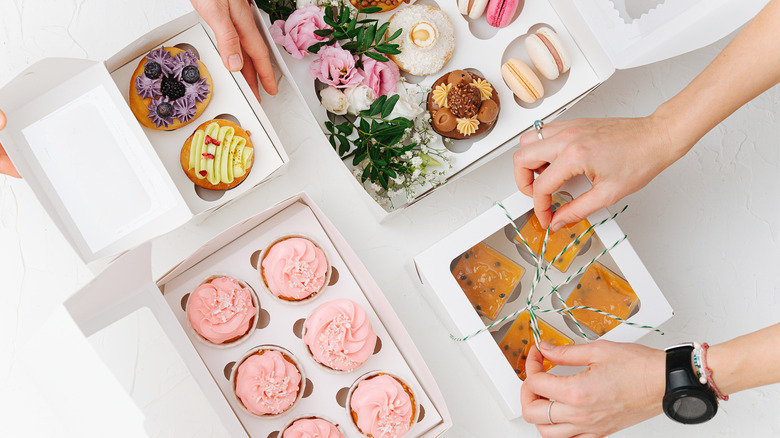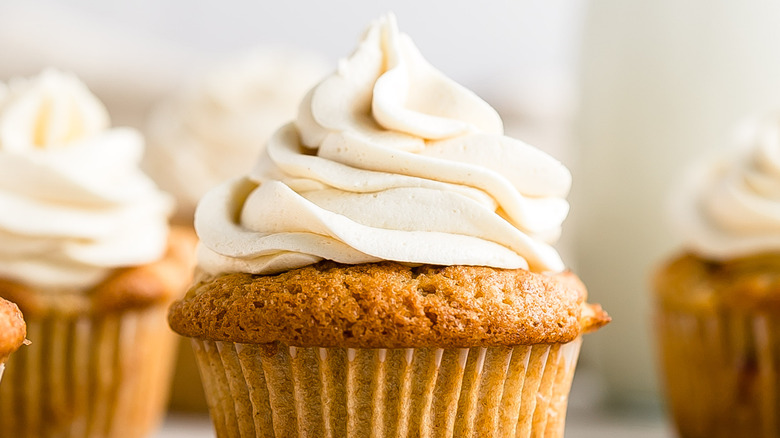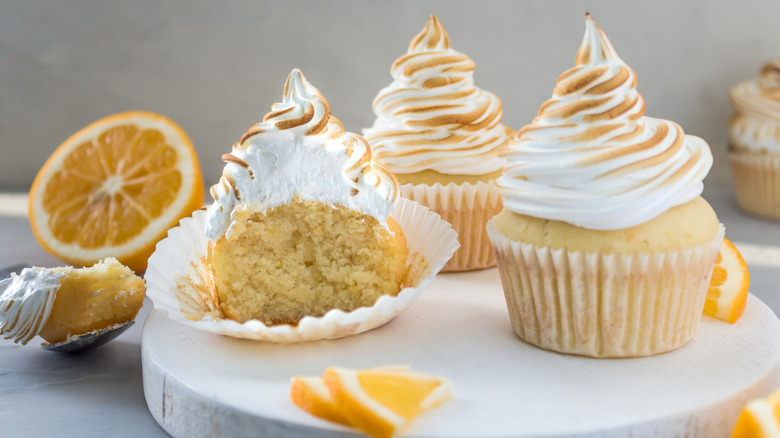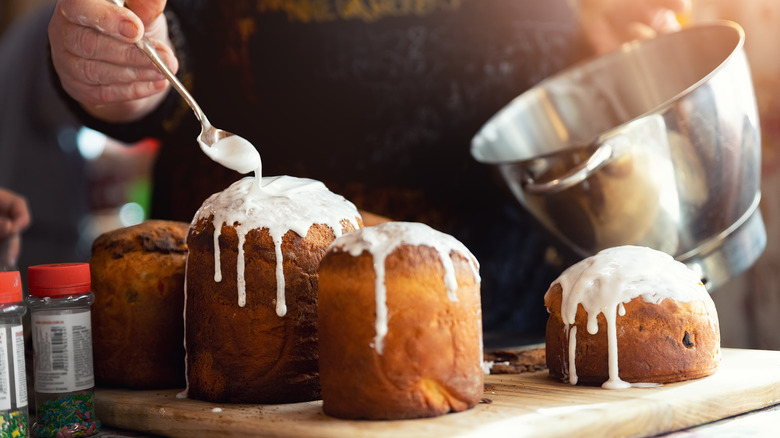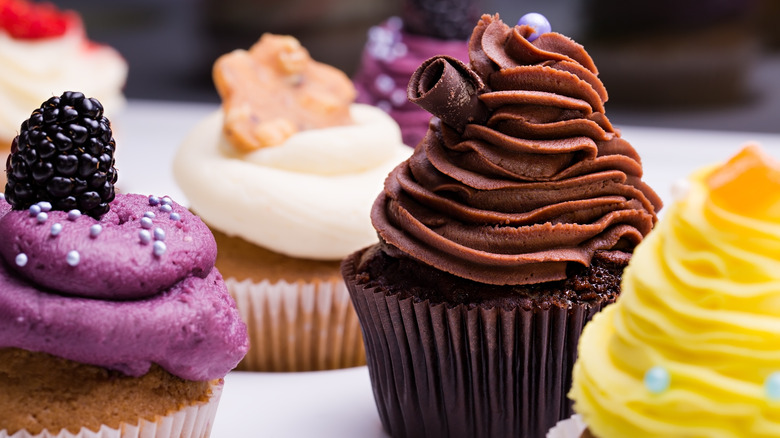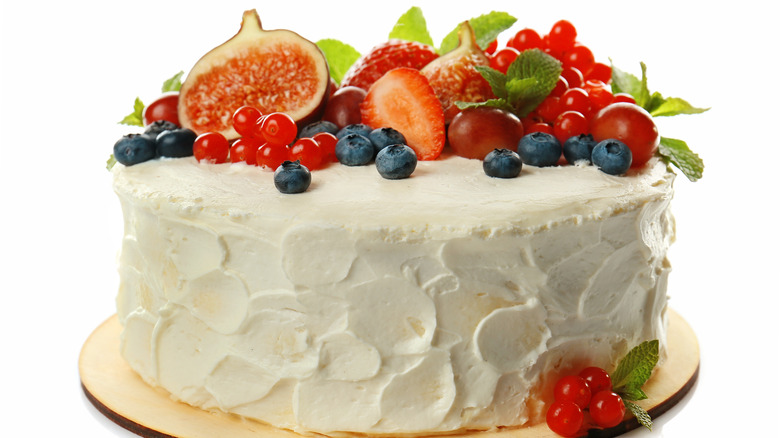Frosting Vs. Icing: How Are They Different?
Chances are you have a preference for frosting or icing, even if it's just a subconscious preference. You might lean towards a decadently frosted layer cake rather than a bundt cake with icing falling down its sides. Or perhaps you like a crisp cookie with cleanly piped royal icing decorations instead of a cupcake standing tall with frosting. But whatever kind of baked sweet treats you like most, chances are you use the terms frosting and icing interchangeably.
It's understandable too. They're both sweet toppings and the difference between the two isn't obviously clear, though differences do exist. Besides the primary differences between the two, there are numerous variations on each to be explored and enjoyed.
Icing isn't as thick as frosting and tends to run. The advantage to that is it's therefore great for glazing cakes or cookies. Frosting is stiffer and is used both inside and outside of cakes. But there are more characteristics that distinguish the two than that.
What is frosting?
There are tons of frosting varieties, but the overarching base for frosting is always some kind of fat (via Tablespoon). Be it cream, beaten butter, cream cheese or whipped egg whites, frosting always starts with some form of fat. Sugar, flavors and even food coloring can then be added to complete the frosting. With fat serving as the base, frosting tends to be more solid which in turn makes it more thick and fluffy and perfect for covering baked goods since it will not move once applied.
The kind of frosting most Americans know and love is American buttercream frosting. This basic buttercream frosting calls for butter as the base which is then beaten until it is soft and creamy. Confectioner's sugar is added along with a touch of liquid like milk as well as any flavorings you plan to add. All of the ingredients are beaten and whipped together in a stand mixer or with a hand mixer until a smooth and luscious mixture forms. You can also add in food coloring with the other liquids before you whip everything together. Cream cheese frosting is also a popular option. It's made the same way that American buttercream frosting is, but the butter is substituted for cream cheese.
Meringue-style frostings
Another couple of frosting types that are similar are Swiss meringue buttercream frosting and Italian meringue buttercream frosting. As Martha Stewart explains, Swiss meringue buttercream starts by gently cooking egg whites and white sugar in a double boiler until the sugar is dissolved and the mixture is thick. Then, you transfer it to a stand mixer or bowl that can accommodate a hand mixer and whip the egg white mixture until it develops peaks. Once the eggs start to form peaks, you add soft butter in and continue to beat it until it is smooth and homogenous.
Italian meringue buttercream frosting is similar, but the egg whites are whipped on their own before hot simple syrup is added. The key difference between Italian and Swiss meringue buttercream frostings is the point at which the sugar is added to the egg whites. Butter is also introduced and whipped with the egg white mixture until the frosting is light and fluffy with a bit of shine. This frosting should almost look like marshmallow filling, but shinier.
What is icing?
While the base of frosting is some kind of softened yet solid fat, the primary base ingredient for icing is powdered sugar, which dissolves very quickly and easily when liquid is added (via Tablespoon). This is what makes icing less stiff and more runny than frosting. In fact, the simplest form of icing is just that — powdered sugar mixed with a liquid.
To make icing, all you have to do is combine the confectioners' sugar with a wide variety of liquids. The most basic choice might be milk, but you can use other liquids to add flavor. For example, fruit juices or liqueurs can be used. You can even make vegan icing if you opt for a plant-based milk instead of dairy milk.
Royal icing is a stiffer version of icing that calls for egg whites or meringue powder to help the icing firm up and dry faster. This icing is very strong, but you can also play with how much liquid you add to make royal icing or flooding icing. Having two consistencies allows you to draw, outline or pipe a design on something like a cookie before using the thinner flooding icing to fill in the open space within the thicker royal icing border.
What does each taste like?
While you can certainly flavor both frosting and icing be it with extracts or liquids like juice and liqueur, frosting and icing have distinct flavors besides sweet. Without any extra flavorings and in their respective purest forms, the taste of both frosting and icing reflects their base ingredients.
Frosting has a sweet cream flavor thanks to its butter base. That's why frosting tends to have a richer, creamier flavor that tastes more buttery. Since the butter is on such display in frosting, it's a good idea to splurge for better or high-quality butter in the frosting even if you don't use the best butter in the baked good itself.
Icing, on the other hand, is very sweet since its base is powdered sugar. The flavor of the liquid used to bring the icing together is also showcased. Therefore, if you use milk, one with a higher fat content will provide a richer, creamier flavor than say skim milk. Otherwise, the icing will taste like a very sweet version of whatever liquid you use such as lemon juice, earl grey tea or even Kahlua.
Can you substitute one for the other?
Generally, frosting and icing can be substituted for one another, but there are a few stipulations that depend on what you are using it for. For example, icing will not work very well to fill in between the layers of a cake because it could easily be absorbed into the cake or it could leak out the sides. You could, however, use an icing to glaze a cake instead of frosting it.
Similarly, frosting things like cinnamon rolls, bundt cakes, loaf cakes or even cookies is possible, but you won't have the same effect as a traditional icing. Frosting will sit heavier on top of the baked goods and is much stiffer. That means you really have to spread it to all of the nooks and crannies you want covered since it won't run there on its own.
There are a few other substitutes you can use in a pinch, too. For example, a jar of hot fudge topping or caramel topping can be warmed up and poured or drizzled over baked goods in place of frosting or icing. You can also use a jam or jelly to fruit glaze a baked good topped with fresh fruit.
So no matter what you're making, consider the type, texture and flavor of topping you'd like before you choose between a frosting or icing.
